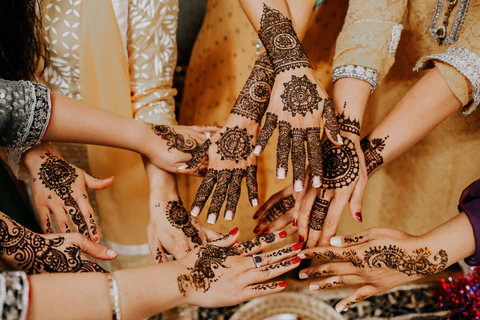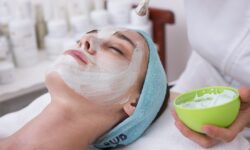
Beauty has always been more than skin deep. Across centuries, it has symbolized identity, heritage, and even social status. From the intricate henna patterns of ancient cultures to today’s glossy runways of Paris, Milan, and New York, beauty rituals have transformed dramatically — yet their essence remains the same: the pursuit of self-expression and connection. But as globalization, fashion, and technology reshape the world, how do traditional beauty practices like henna coexist with the glamour and speed of modern high fashion?
The Ancient Language of Beauty
Long before lipsticks, highlighters, and designer perfumes, beauty was woven into cultural practices. In many parts of the Middle East, Africa, and South Asia, henna was not just decoration — it was storytelling. The intricate swirls and floral motifs painted onto hands and feet carried meanings of joy, fertility, and blessings.
Henna ceremonies, especially during weddings, served as rites of passage. The ritual was deeply communal, often accompanied by music, dance, and laughter. Similarly, in ancient Egypt, kohl eyeliner was more than a cosmetic. It was believed to protect against the harsh desert sun and even ward off evil spirits. These early rituals tied beauty to spirituality, health, and cultural identity.
The Renaissance of Rituals
As civilizations evolved, so did beauty. The Renaissance period in Europe emphasized powdered faces and elaborate hairstyles, symbolizing wealth and nobility. Meanwhile, in Asia, beauty took on different forms. Japanese geishas used rice powder and bold red lips to create iconic looks, while Indian women applied turmeric for both skincare and ritual purification.
These rituals were often time-consuming and rooted in tradition. They emphasized harmony, symbolism, and societal belonging, reflecting how beauty was as much about ritual as it was about aesthetics.
The Industrial Revolution and the Birth of Modern Beauty
The 19th and 20th centuries introduced a seismic shift in beauty practices. Industrialization made cosmetics more accessible, moving them from royal courts and rituals into everyday households. Suddenly, makeup was not just for queens or brides but for ordinary women seeking self-expression.
Brands like Max Factor, Revlon, and Estée Lauder turned beauty into an industry, advertising products that promised glamour, youth, and confidence. Beauty became democratized — but also commercialized. High fashion, led by icons like Coco Chanel, merged beauty with luxury, making it a statement of modern sophistication.
Yet even as glossy magazines dictated trends, traditional beauty rituals persisted. Brides in Morocco still wore henna, and Middle Eastern women continued to use natural oils like argan and oud. The old and the new began to blend, setting the stage for today’s globalized beauty culture.
Henna in the Age of Instagram
Fast forward to the 21st century: beauty has entered the digital age. Social media platforms like Instagram and TikTok have turned makeup tutorials, skincare hacks, and fashion shows into viral content. Influencers shape trends as powerfully as fashion houses, and beauty is now a billion-dollar global conversation.
And yet, henna — an ancient ritual — thrives. From Beyoncé’s stage performances to Coachella-inspired fashion, henna has become a symbol of cultural fusion. Its once-local patterns now appear on red carpets and global runways, embraced as both traditional art and contemporary accessory.
This digital spotlight has sparked important conversations, too. While some celebrate henna’s global popularity, others raise questions of cultural appropriation versus cultural appreciation. In this sense, beauty rituals are no longer passive traditions; they are active dialogues about heritage, respect, and identity.
High Fashion’s Redefinition of Beauty
High fashion, once limited to elite circles, has also transformed. Runway shows now embrace diversity, showcasing models of different skin tones, body shapes, and cultural backgrounds. Designers are increasingly drawing from traditional aesthetics, blending them into futuristic visions.
For instance, haute couture collections have incorporated elements of tribal makeup, Middle Eastern patterns, and even natural dyes reminiscent of henna. Beauty rituals are no longer confined to local spaces; they are part of a global fashion vocabulary.
Technology has also elevated beauty to new dimensions. From AI-designed makeup looks to augmented reality fitting rooms, beauty and fashion now exist at the crossroads of tradition, innovation, and personalization.
The Timeless Thread: Self-Expression
So, are we moving away from rituals like henna, or are they being reborn in new forms? The truth lies somewhere in between. Beauty, whether rooted in heritage or driven by high fashion, continues to serve one purpose: self-expression.
Henna remains a symbol of identity and celebration in countless cultures, while high fashion represents reinvention and boundary-pushing. Together, they show that beauty rituals are not about competition, but about coexistence. One is timeless, grounding us in history; the other is ever-changing, pushing us toward the future.
Looking Ahead: The Future of Beauty
As sustainability and inclusivity dominate conversations in fashion and beauty, traditions like henna are gaining renewed relevance. Natural, eco-friendly, and cultural beauty practices align perfectly with today’s conscious consumerism. Meanwhile, high fashion continues to set aspirational standards, but with greater awareness of cultural roots and global diversity.
We are entering an era where a bride in Abu Dhabi might wear henna while also adorning herself in high-fashion couture, or where a runway model might showcase ancient motifs reimagined for modern audiences. The blend of past and present, tradition and innovation, is not only possible but inevitable.
Conclusion
From henna’s intricate patterns to the polished glamour of high fashion, the evolution of beauty rituals tells a larger story of humanity’s journey. It is a story of culture, creativity, and connection — where tradition grounds us, and fashion propels us forward. Beauty may change its face over time, but its heartbeat remains the same: a universal language of expression that transcends borders, generations, and trends.




